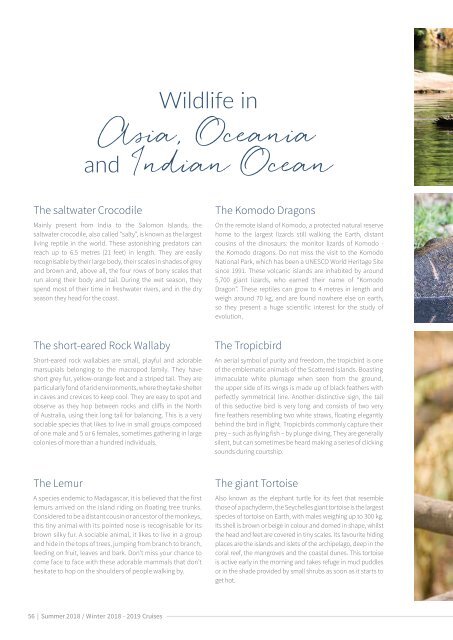LUXURY EXPEDITIONS 2018-2019
Create successful ePaper yourself
Turn your PDF publications into a flip-book with our unique Google optimized e-Paper software.
Wildlife in<br />
Asia, Oceania<br />
and Indian Ocean<br />
The saltwater Crocodile<br />
Mainly present from India to the Salomon Islands, the<br />
saltwater crocodile, also called “salty”, is known as the largest<br />
living reptile in the world. These astonishing predators can<br />
reach up to 6.5 metres (21 feet) in length. They are easily<br />
recognisable by their large body, their scales in shades of grey<br />
and brown and, above all, the four rows of bony scales that<br />
run along their body and tail. During the wet season, they<br />
spend most of their time in freshwater rivers, and in the dry<br />
season they head for the coast.<br />
The short-eared Rock Wallaby<br />
Short-eared rock wallabies are small, playful and adorable<br />
marsupials belonging to the macropod family. They have<br />
short grey fur, yellow-orange feet and a striped tail. They are<br />
particularly fond of arid environments, where they take shelter<br />
in caves and crevices to keep cool. They are easy to spot and<br />
observe as they hop between rocks and cliffs in the North<br />
of Australia, using their long tail for balancing. This is a very<br />
sociable species that likes to live in small groups composed<br />
of one male and 5 or 6 females, sometimes gathering in large<br />
colonies of more than a hundred individuals.<br />
The Komodo Dragons<br />
On the remote island of Komodo, a protected natural reserve<br />
home to the largest lizards still walking the Earth, distant<br />
cousins of the dinosaurs: the monitor lizards of Komodo -<br />
the Komodo dragons. Do not miss the visit to the Komodo<br />
National Park, which has been a UNESCO World Heritage Site<br />
since 1991. These volcanic islands are inhabited by around<br />
5,700 giant lizards, who earned their name of “Komodo<br />
Dragon”. These reptiles can grow to 4 metres in length and<br />
weigh around 70 kg, and are found nowhere else on earth,<br />
so they present a huge scientific interest for the study of<br />
evolution.<br />
The Tropicbird<br />
An aerial symbol of purity and freedom, the tropicbird is one<br />
of the emblematic animals of the Scattered Islands. Boasting<br />
immaculate white plumage when seen from the ground,<br />
the upper side of its wings is made up of black feathers with<br />
perfectly symmetrical line. Another distinctive sign, the tail<br />
of this seductive bird is very long and consists of two very<br />
fine feathers resembling two white straws, floating elegantly<br />
behind the bird in flight. Tropicbirds commonly capture their<br />
prey − such as flying fish − by plunge diving. They are generally<br />
silent, but can sometimes be heard making a series of clicking<br />
sounds during courtship.<br />
The Lemur<br />
A species endemic to Madagascar, it is believed that the first<br />
lemurs arrived on the island riding on floating tree trunks.<br />
Considered to be a distant cousin or ancestor of the monkeys,<br />
this tiny animal with its pointed nose is recognisable for its<br />
brown silky fur. A sociable animal, it likes to live in a group<br />
and hide in the tops of trees, jumping from branch to branch,<br />
feeding on fruit, leaves and bark. Don’t miss your chance to<br />
come face to face with these adorable mammals that don’t<br />
hesitate to hop on the shoulders of people walking by.<br />
The giant Tortoise<br />
Also known as the elephant turtle for its feet that resemble<br />
those of a pachyderm, the Seychelles giant tortoise is the largest<br />
species of tortoise on Earth, with males weighing up to 300 kg.<br />
Its shell is brown or beige in colour and domed in shape, whilst<br />
the head and feet are covered in tiny scales. Its favourite hiding<br />
places are the islands and islets of the archipelago, deep in the<br />
coral reef, the mangroves and the coastal dunes. This tortoise<br />
is active early in the morning and takes refuge in mud puddles<br />
or in the shade provided by small shrubs as soon as it starts to<br />
get hot.<br />
56 | Summer <strong>2018</strong> / Winter <strong>2018</strong> - <strong>2019</strong> Cruises


